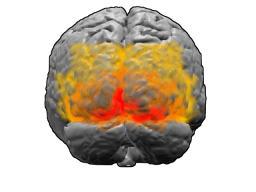
Brodmann area 19 is shown in yellow in this image which also shows areas 17 (red) and 18 (orange)
Human[]
Brodmann area 19, or BA19, is part of the occipital lobe cortex in the human brain. Along with area 18, it comprises the extrastriate (or peristriate) cortex. In normally-sighted humans, extrastriate cortex is a visual association area, with feature-extracting, shape recognition, attentional, and multimodal integrating functions.
This area is also known as peristriate area 19, and it refers to a subdivision of the cytoarchitecturally defined occipital region of cerebral cortex. In the human it is located in parts of the lingual gyrus, the cuneus, the lateral occipital gyrus (H) and the superior occipital gyrus (H) of the occipital lobe where it is bounded approximately by the parieto-occipital sulcus. Cytoarchitecturally it is bounded on one side by the parastriate area 18 which it surrounds. Rostrally it is bounded by the angular area 39 (H) and the occipitotemporal area 37 (H) (Brodmann-1909).
Guenon[]
Brodmann area 19-1909 is a subdivision of the cerebral cortex of the guenon defined on the basis of cytoarchitecture. It is cytoarchitecturally homologous to the peristriate area 19 of the human (Brodmann-1909). Distinctive features (Brodmann-1905): Compared to Brodmann area 18-1909, the pyramidal cells of sublayer 3b of the external pyramidal layer (III) are not as densely distributed, the layer is not as narrow, and its boundary with the internal granular layer (IV) is not as distinct; the cells in sublayer 3b are concentrated at its outer boundary leaving a narrow clear zone with no large pyramidal cells adjacent to layer IV; the granule cells of layer IV are less densely distributed and are intermixed with larger polymorphic cells so that, while the layer is still quite dark and prominent, it is somewhat widened and not as self-contained; the internal pyramidal layer (V) is characterized by large pyramidal ganglion cells, most in small groups, a pattern not seen in area 18; the cells in the multiform layer (VI) are clearly larger than in area 18; overall area 19 is somewhat thicker and less densely populated than area 18.
Function[]
Area 19 is a histologically delineated band anterolaterally abutting visual area 18. Single-cell electrophysiological recordings from area 19 in the cat suggest sensitivity to motion-delineated forms; recordings from primates have yielded varying results, indicating that this area may be a heterogeneous collection of visual areas, with multiple incomplete representations of the visual scene.
In humans, this band putatively contains regions of the visual areas designated V3, V4 and V6 in the primate. Functional magnetic resonance imaging shows some degree of retinotopic mapping. The area has reciprocal connections with areas 17 and 18, as well as posterior parietal association areas.
Area 19 has been noted to receive inputs from the lateral geniculate nucleus via the pulvinar, and may contribute to the phenomenon of blindsight. In patients blind from a young age, the area has been found to be activated by somatosensory stimuli.
Because of these findings, it is thought that area 19 is the differentiation point of the two visual streams, of the 'what' and 'where' visual pathways. The dorsal region may contain motion-sensitive neurones, and ventral areas may be specialised for object recognition.
External links[]
- For Neuroanatomy of the peristriate area 19 visit BrainInfo
- For Neuroanatomy of Brodmann area 19 visit BrainInfo
See also[]
References[]
- Hyvarinen, J., Carlson, Y. and Hyvarinen, L. (1981) Early visual deprivation alters modality of neuronal responses in area 19 of monkey cortex, Neurosci. Lett. 26, 239–243
- Theories of visual cortex organization in primates: areas of the third level, Prog Brain Res. 1996;112:213-21
| This page uses Creative Commons Licensed content from Wikipedia (view authors). |